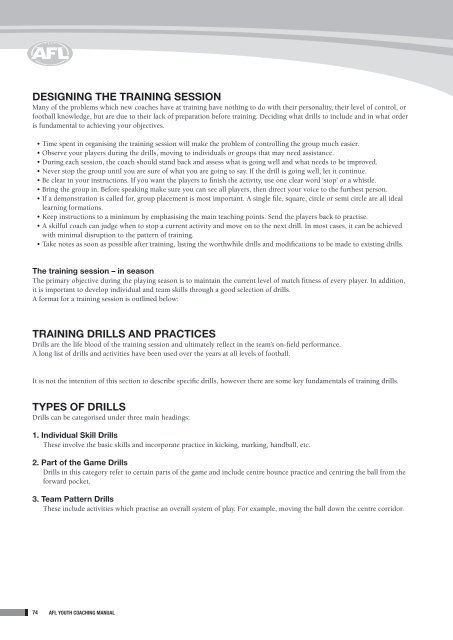2012 Youth Coaching Manual - AFL Community
2012 Youth Coaching Manual - AFL Community
2012 Youth Coaching Manual - AFL Community
Create successful ePaper yourself
Turn your PDF publications into a flip-book with our unique Google optimized e-Paper software.
Designing the training session<br />
Many of the problems which new coaches have at training have nothing to do with their personality, their level of control, or<br />
football knowledge, but are due to their lack of preparation before training. Deciding what drills to include and in what order<br />
is fundamental to achieving your objectives.<br />
• Time spent in organising the training session will make the problem of controlling the group much easier.<br />
• Observe your players during the drills, moving to individuals or groups that may need assistance.<br />
• During each session, the coach should stand back and assess what is going well and what needs to be improved.<br />
• Never stop the group until you are sure of what you are going to say. If the drill is going well, let it continue.<br />
• Be clear in your instructions. If you want the players to finish the activity, use one clear word ‘stop’ or a whistle.<br />
• Bring the group in. Before speaking make sure you can see all players, then direct your voice to the furthest person.<br />
• If a demonstration is called for, group placement is most important. A single file, square, circle or semi circle are all ideal<br />
learning formations.<br />
• Keep instructions to a minimum by emphasising the main teaching points. Send the players back to practise.<br />
• A skilful coach can judge when to stop a current activity and move on to the next drill. In most cases, it can be achieved<br />
with minimal disruption to the pattern of training.<br />
• Take notes as soon as possible after training, listing the worthwhile drills and modifications to be made to existing drills.<br />
The training session – in season<br />
The primary objective during the playing season is to maintain the current level of match fitness of every player. In addition,<br />
it is important to develop individual and team skills through a good selection of drills.<br />
A format for a training session is outlined below:<br />
Training drills and practices<br />
Drills are the life blood of the training session and ultimately reflect in the team’s on-field performance.<br />
A long list of drills and activities have been used over the years at all levels of football.<br />
It is not the intention of this section to describe specific drills, however there are some key fundamentals of training drills.<br />
Types of drills<br />
Drills can be categorised under three main headings:<br />
1. Individual Skill Drills<br />
These involve the basic skills and incorporate practice in kicking, marking, handball, etc.<br />
2. Part of the Game Drills<br />
Drills in this category refer to certain parts of the game and include centre bounce practice and centring the ball from the<br />
forward pocket.<br />
3. Team Pattern Drills<br />
These include activities which practise an overall system of play. For example, moving the ball down the centre corridor.<br />
74 <strong>AFL</strong> <strong>Youth</strong> <strong>Coaching</strong> <strong>Manual</strong>

















